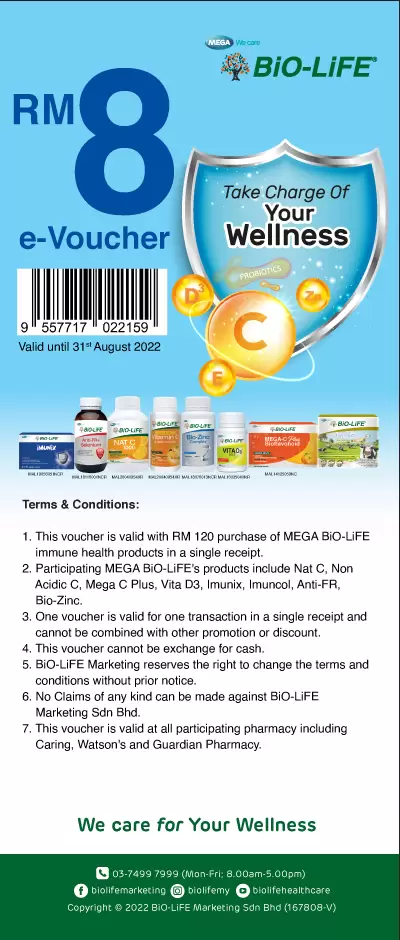
Seize the “C” with Bioflavonoids
Dec 27, 2018
Introduction
Vitamin C supplement is always the common supplement that we choose to take because it is one of the essential vitamins that our body unable to produce.
Vitamin C
Vitamin C, also known as ascorbic acid, is a water-soluble vitamin that plays several roles in our human body. It is always recognized as a powerful antioxidant that able to scavenge the free radicals from harming the body cells [1]. Due to the scavenging property of vitamin C, it is said to be able to improve our immune system when our body has a sufficient level of vitamin C.
The daily requirement of vitamin C
According to Recommended Nutrient Intake (RNI) Malaysia 2017, the recommended vitamin C intake per day is 70mg/day. Furthermore, the total vitamin C pool that needs to be maintained in our body ranges from 300mg to 2g in healthy individuals [2]. Thus, we need to achieve our daily requirement by consuming vitamin C rich fruits and vegetables. However, the low amount of fruits and vegetables consumption in general population in Malaysia [3] along with the environment that is full of radicals, meeting the daily requirement of vitamin C becomes a challenging task. Also, for individual who has a poor immune system, or is a smoker, may need to maintain a greater amount of vitamin C pool in the body. Hence, a higher dosage of vitamin C consumption or supplementation may need to be considered for achieving optimum health functions from it. In line with the challenging amount of vitamin C level that needs to be obtained, bioflavonoids have recently become an effective helper in boosting our vitamin C level and immune system.
Bioflavonoids
Bioflavonoids, also known as flavonoids, are a group of plant pigments which give colour to many flowers and fruits. These colourful biochemical compounds a lot of health benefits to the human body, for example:

It is not just “Vitamin C” – BiO-LiFE’s Nat C
BiO-LiFE’s Nat C is a convenient alternative for you to get a sufficient amount of vitamin C per day. One tablet of Nat C is containing 1000 mg of vitamin C that is a sufficient amount to combat free radicals and replenish the vitamin C pool in our body. Moreover, the 6-in-1 formula that is containing many other bioflavonoids able to increase the absorption rate of vitamin C and strengthen the immune system. Get yourself a BiO-LiFE’s Nat C today and feels the difference!
References
- Carpenter KJ. The discovery of vitamin C. Annals of Nutrition and Metabolism. 2012;61(3):259-64.
- Recommended Nutrient Intake Malaysia 2017.
- Padayatty SJ, Katz A, Wang Y, Eck P, Kwon O, Lee JH. Vitamin C as an antioxidant: evaluation of its role in disease prevention. Journal of the American college of Nutrition. 2003 Feb 1;22(1):18-35.
- Vinson JA, Bose P. Comparative bioavailability to humans of ascorbic acid alone or in a citrus extract. The American journal of clinical nutrition. 1988 Sep 1;48(3):601-4.
- Russo A, Acquaviva R, Campisi A, Sorrenti V, Di Giacomo C. Bioflavonoids as antiradicals, antioxidants and DNA cleavage protectors. Cell biology and toxicology. 2000 Apr 1;16(2):91.
- Tejada S, Pinya S, Martorell M, Capó X, Tur JA, Pons A, Sureda A. Potential anti-inflammatory effects of hesperidin from the genus Citrus. Current medicinal chemistry. 2017 Jul.
- Ramful D, Tarnus E, Aruoma OI, Bourdon E, Bahorun T. Polyphenol composition, vitamin C content and antioxidant capacity of Mauritian citrus fruit pulps. Food Research International. 2011 Aug 1;44(7):2088-99.
- Bruno, G. (2002). Vitamin C & Bioflavonoids. [ebook] Knoxville: Huntington College of Health Sciences, p.1. Available at: https://www.huhs.edu/literature/Vitamin%20C.pdf [Accessed 10 Dec. 2018].
- Orthomolecular.org. (2018). Vitamin P. [online] Available at: http://orthomolecular.org/nutrients/p.html [Accessed 10 Dec. 2018].
- dos Santos Garcia VA, da Silva MR, Seixas FA. RAPID ANALISYS OF VITAMIN-C CONTENT IN ACEROLA EXTRACT BY FT–NIR SPECTROSCOPY. Revista Tecnológica. 2013 Jan 17;22(1):13-21.
- Belwal T, Devkota HP, Hassan HA, Ahluwalia S, Ramadan MF, Mocan A, Atanasov AG. Phytopharmacology of Acerola (Malpighia spp.) and its potential as functional food. Trends in food science & technology. 2018 Feb 1.
- Patel S. Rose hips as complementary and alternative medicine: overview of the present status and prospects. Mediterranean journal of nutrition and metabolism. 2013 Jan 1;6(2):89-97.
- Perry, L. (2018). Rose Hips. [online] Pss.uvm.edu. Available at: https://pss.uvm.edu/ppp/articles/rosehips.html [Accessed 10 Dec. 2018].
- Mármol I, Sánchez-de-Diego C, Jiménez-Moreno N, Ancín-Azpilicueta C, Rodríguez-Yoldi M. Therapeutic applications of rose hips from different Rosa species. International journal of molecular sciences. 2017 Jun;18(6):1137.



